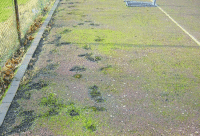
Moving through February, the forecast is for it to remain changeable, with unsettled spells interspersed with colder, showery interludes. The most unsettled and windy weather is likely to occur in the north and northwest while the south and southeast should see somewhat drier conditions overall, though even here, some rain and strong winds are likely.
If the frosty weather persists over a number of days, it could lead to a number of problems with your irrigation systems, hose pipes and outside taps. Ideally, any water carrying pipe work should be lagged or protected from frost damage, as this will lead to burst pipes and joints; make sure you keep an eye open for these leaks.
Key Tasks for February

As stated previously, if the court is frozen, keep off; you will do more harm than good.
General maintenance, dependent upon weather conditions:
- continue to cut as required, ensuring that you take no more than a third off in any one cut. Maintain a height of cut between 12-18mm
- a cylinder mower may still be used, but it is more likely that a rotary mower will serve you better
- box clippings to avoid the spread of disease
- remove leaves and other debris as soon as possible – a rotary mower does a good job
Artificial courts
Keep surface clean with regular sweeping and brushing
Remove any algae and moss from surface. Sand filled systems require regular brushing to maintain manufacturer’s recommendations on sand levels and pile heights
American Fast Dry courts
- keep surface clean, rolling to consolidate surface
- levelling and brushing of fast dry materials, brushing to clean lines
Clay courts
- carry out regular sweeping and brushing to restore levels
- topdress any hollows or damaged areas
Tarmacadam
- carry out regular sweeping and brushing
- repair any hollows or damaged areas
With many clubs allowing and, indeed encouraging, play on their artificial surfaces through the winters months (when weather conditions allow) it is imperative that these courts are completely free from moss, algae, leaves or anything else that might pose a slip hazard.




As daytime temperatures potentially begin to warm, it is important to nurse the grass plant through the end of winter with a gentle amount of NPK fertiliser, either as little and often foliar applications or with a conventional release mineral fertiliser. The aim should be to keep the plant healthy, not to force growth, as excess nutrition will either go to waste when cold or force the plant on too much when warmer, in turn making soft young growth susceptible to damage from the harsh winds and temperatures during cold snaps and fungal attack in warm, damp, still periods.
Sulphur is an important nutrient when it comes to assisting plant metabolic function early in the season. So, planning now to apply a feed in March, which contains a high percentage of this vital element, should be considered.
Towards the end of the month, the sun may begin to feel noticeably warm in sheltered areas, but turf managers should be mindful that it is soil temperatures which drive growth with night time temperatures the biggest contributing factor to average soil temperatures throughout the day.
Put simply:
warm day and warm night = warming soil temperatures
warm day and cold night = stable soil temperatures
February represents a good time to undertake PWS testing on your surfaces. A cost effective broad spectrum soil analysis is available from the Pitchcare shop, with the subsequent report giving you a tangible point of reference as to what the soil requires when it comes to planning your spring and summer fertiliser applications.
Implementing an integrated turf management approach to managing disease is the responsible way to approach this issue, reducing periods of extended leaf blade wetness to a minimum by either removing dews by brushing or switching. Dew dispersal products offer a solution for this situation on club facilities where daily removal by hand is more difficult.
Keeping an eye on weather forecasts, and applying fungicides in good time when weather conditions are predicted to be the most conducive for disease development, is the best way to minimise damage. Once obvious damage is evident, applications are entering into a curative phase. The most effective and responsible approach is to aim for a preventative or early curative regime whereby diseases, and in particular microdochium patch, are treated prior to, or at the earliest signs of infection.
Aeration, as always, continues to be of utmost importance and should be undertaken whenever conditions allow good recovery and the risk of damaging wet soils is at a minimum.
If moisture and warmth coincide towards the end of the month, then it is an opportunity to seed any remaining small bare patches which might have lingered over winter, although germination will be slow especially if colder weather then intervenes.
Brushing or switching of the playing surface keeps the green clean and removes any dew or surface water. Keeping the surface dry will aid resistance to disease.
The typical types of diseases you may come across are:
- Fusarium Patch
- Red Thread
- Fairy Rings
- Anthracnose
Use appropriate fungicides to control any further outbreaks, however, with the grass soon beginning to grow, it won't take long for these scars to grow out.
Please note: More information on these and many others can be found here: https://www.pitchcare.com/useful/diseases.php
All personnel should be suitably qualified in the application of chemicals, having gained PA1/ PA6 certificates for hand held spraying or PA2 certificate for tractor or vehicle spraying - see the Grounds Training website for information on courses.
Worm activity can be quite prevalent during the winter months, especially during periods of mild weather. Worm treatments can be carried out if needed, but please remember to ask yourself why worms are present. pH levels, organic matter and your cultural practices on the square need to be assessed. Carbendazim is now the only active ingredient available for controlling worms - for the time being; it is still available for purchase up to the end of May 2017, and the end of August 2017 as the final date for its use, storage or disposal - Carbendazim Products
With some machines not currently being used, take the time to carry out an overhaul or send them away for a service.
- inspect and clean machinery before putting away for the winter
- replace worn and damaged parts as necessary
- empty fuel tanks as petrol will go stale over winter
- maintain a stock of consumables for your machinery
- secure machinery nightly with good storage facilities and strong locks
- record makes and models and take pictures of your equipment as additional reference
- don’t leave it to the last minute when servicing dealers will be very busy

Some of the courses available are:
- Chainsaws - CS30 and CS31
- H&S Refresher Training on Combined Turf Care Equipment; Tractors and Trailers; All Mowers (Ride-on and Pedestrian)
- Machinery Courses on ATVs; Tractors: Brushcutters/Strimmers; Mowers (ride-on and Pedestrian)
- Pesticide Application (PA courses)
- Stem Injection of Invasive Species (Japanese Knotweed etc.)
- Basic Trees Survey and Inspection
More details about all the courses can be found on our new Grounds Training website, or you can email Chris Johnson for information.
- repair and maintain fence lines
- cut back any hedges and trees and prune shrubs
- take down and store all tennis equipment, ensuring that it is clean and dry before doing so
- repair/update equipment as necessary
Whilst many of the above actions may appear to be common sense, it is surprising how some things can get overlooked, often due to the lack of daylight hours. The more that club members, players and officials understand what you role involves, the better. You could use any spare time to provide a members newsletter/blog detailing what problems you are experiencing (disease outbreaks, algae and moss, waterlogging etc.) and to seek additional help as required
Articles you may find helpful
https://www.pitchcare.com/magazine/edgbaston-priory-58773038987dc.html
https://www.pitchcare.com/magazine/refurbishing-existing-surfaces.html
https://www.pitchcare.com/magazine/synthetic-tennis-courts-dealing-with-migration.html
https://www.pitchcare.com/magazine/busy-time-at-the-priory.html
https://www.pitchcare.com/magazine/walmer-tennis-club-racquet-mallet-and-renovation.html


